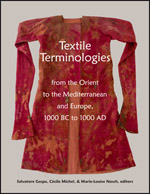Centre for Textile Research
Date of this Version
2017
Document Type
Article
Citation
In Textile Terminologies from the Orient to the Mediterranean and Europe, 1000 BC to 1000 AD, ed. Salvatore Gaspa, Cécile Michel, & Marie-Louise Nosch (Lincoln, NE: Zea Books, 2017), pp. 321-345.
doi:10.13014/K2XD0ZVC
Abstract
The principal element of the fashion in clothing introduced in Egypt with the arrival of the Romans was a tunic made of two rectangular pieces of fabric sewn together. Such a tunic either would leave the arms naked, or cover the arms to the elbow (fig. 1). This fashion changed with the turn of the 2nd and 3rd century AD. At this time, in addition to the tunics without sleeves, the inhabitants of Egypt started to wear tunics with ‘true’ sleeves – long or short, wide or tight – inspired by the Eastern fashion: the manner of making the tunics changed and the decorative motifs became richer. The tunics were woven to shape, either in one piece (fig. 3) or, probably starting from the 5th century AD, were made up of three pieces stitched together (fig. 4). As for the sleeveless tunics, they were also woven in only one piece (fig. 2). In the 6th-7th century AD Egypt, one could see a certain influence of the style probably coming from Sassanid Persia. Amongst other things, this tendency was expressed in tunics with long sleeves, sewn in several pieces (fig. 5). These changes in fashion are reflected in the vocabulary concerning the tunics, as attested in the papyrological documents and in the literary texts. Several Greek terms are employed to indicate tunics in the texts written in Egypt at this time: δελματική, καμίσιον, κολόβιον, λεβίτων, στιχάριον, χιτών. Studies focussing on Egyptian tunics and their vocabulary are dispersed in isolated comments and lexicographical articles, as well as in the publications of objects coming from excavations or collections, and they do not exhaust the subject. It is the aim of this paper to present the evolution of the significance of these terms and their employment in the texts coming from Egypt.
Included in
Ancient History, Greek and Roman through Late Antiquity Commons, Art and Materials Conservation Commons, Classical Archaeology and Art History Commons, Classical Literature and Philology Commons, Fiber, Textile, and Weaving Arts Commons, Indo-European Linguistics and Philology Commons, Jewish Studies Commons, Museum Studies Commons, Near Eastern Languages and Societies Commons, Other History of Art, Architecture, and Archaeology Commons


Comments
Copyright © 2017 Salvatore Gaspa, Cécile Michel, & Marie-Louise Nosch. Photographs copyright as noted.